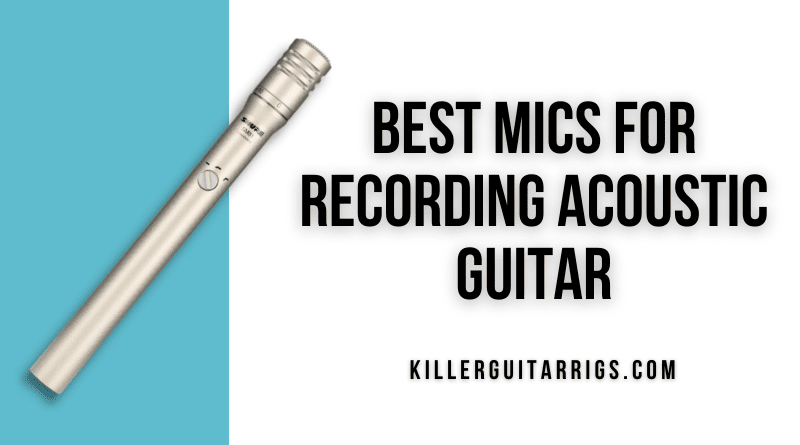Recording the acoustic guitar well is one of the most important abilities that any engineer should master and using the best microphones for recording acoustic guitar will almost always make life easier when doing so. We live in an age where just about anybody has a recording setup, and nowadays, guitarists are expected to be able to record themselves with at least some level of professionalism.
Whether you are working with a songwriter demoing a new song or just laying down some acoustic guitar parts for yourself or someone else, a quality mic is one of the best ways to do this beautiful instrument justice.
But with so many microphone models out there… how do you even go about deciding which one to get? We’re here to help you with that. In this KillerGuitarRigs Review, we’ll be looking at 7 of the best mics for recording acoustic guitar. During the reviews we focused on clarity, build quality, and features.
Keep reading to learn more!
Read more about our review process.

Neumann KM 184 Cardioid Small-diaphragm Condenser Microphone
Features: Cardioid pickup pattern, 20Hz-20kHz Frequency range, Transformerless circuit
Benefits: Exceptionally clear sound, Zero coloration, Extremely low inherent noise

Shure SM81 Small-diaphragm Condenser Microphone
Features: Vinyl-coated steel housing, Includes swivel adapter, Lockable -10dB pad
Benefits: Useable in any condition of temperature and humidity, Accurate tonal reproduction, Delivers low noise and high output
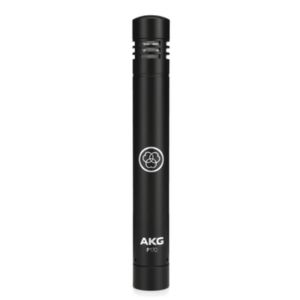
AKG P170 Small-diaphragm Condenser Microphone
Features: Switchable 20dB pad, Metal housing, Cardioid polar pattern
Benefits: Extremely hard wearing, Easy to set up, Pro performance at attainable price
Contents
Our Top 3
The Shure SM81 Small-diaphragm Condenser is our Top Pick. With no coloration, outstanding off-axis rejection, and low noise, this mic has been an industry standard for years.
The AKG P170 is our Best Budget Choice. It comes with the revered AKG quality and gives you transparent and accurate sound on acoustic guitar and other sources.
Finally, the Neumann KM 184 is our Editor’s Choice, from arguably the greatest mic company in history. This microphone is for discerning musicians, producers, and engineers who value quality and want the very best possible option when recording acoustic guitars.
Individual Reviews
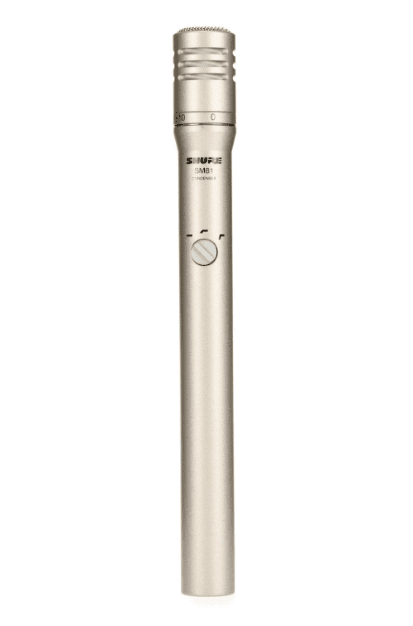
Shure SM81 Small-diaphragm Condenser
An industry standard for good reason.
This mic is a tried and true option to precisely and accurately capture your acoustic guitar. Not only is it a go-to choice for recording acoustic guitars by top engineers everywhere, but it also captures other acoustic instruments quite well.
The Shure SM81 is a small-diaphragm condenser microphone that features a uniform cardioid pickup pattern that achieves maximum gain well before any feedback is present. Additionally, this mic offers outstanding off-axis rejection and is a beloved industry standard for capturing the acoustic guitar.
We put this mic to the test by recording our Gibson Hummingbird acoustic. As expected, the uniform cardioid pickup pattern of the SM81 gave us superior isolation as well as minimum off-axis coloration. These are precisely the traits that made it an industry standard.
In our tests, we got an ultra-smooth response curve that faithfully captured our beloved Hummingbird acoustic. While listening back to the excerpts we recorded, we did not notice any noise, just a high output.
This mic offered us an easy way to get great results. We placed it a foot in front of the 12th fret and did not feel the need to move it around as it captured a balanced tone and every nuance of our playing.
This mic also features a 3-position switch that allows you to modify the low-frequency response. You get to choose between flat, 6 dB, or 18dB/octave roll-off. We had it at the flat position and got great results. However, the other positions are great for situations where you have to minimize wind noise or even room noise.
To top it off, the SM81 features a -10 dB pad that enables you to use it on louder sources without changing its frequency response. In short, a great choice to accurately capture the beauty and nuance of acoustic guitars.
Verdict: The Shure SM81 is a great small-diaphragm condenser microphone with stellar off-axis rejection that lets you capture your acoustic just as it is. This mic has been an industry standard for recording acoustic guitars and remains one of the best choices for engineers and producers of professional and home studios alike.
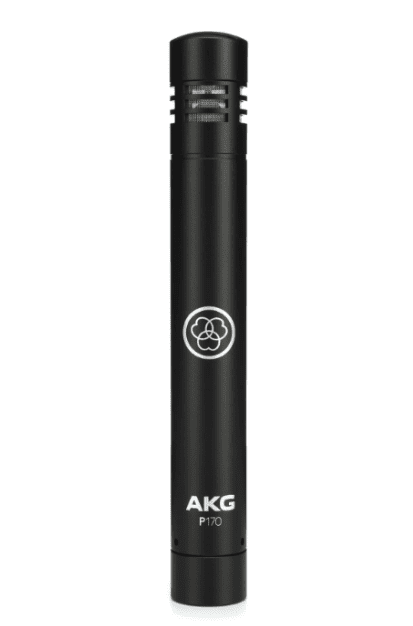
AKG P170
An elegant option from a top mic manufacturer.
AKG has been a top microphone brand for well over half a century. The P170 offers you this brand's legendary quality and tradition to accurately capture your acoustic guitar while remaining within budget.
The AKG P170 is a small-diaphragm condenser microphone that features a cardioid pattern as well as a 20 dB pad to capture hot sources. This mic offers you an exceptionally clear way to capture the sound of your instrument for an impressively low price.
In our tests, we tried this mic positioned right in front of our Gibson Hummingbird at about 12 inches from the 12th fret (right where the neck meets the body). This position is a great place to record acoustic guitars, and we know what sound we get there from our acoustic.
The P170 performed very well, giving us a clear and transparent picture of our instrument. From slight strumming to forcefully played riffs, this AKG pencil condenser captured our playing with accuracy. Even when we played aggressively loud, the P170 never sounded shrill and remained transparent.
We did not even have to engage the 20 dB pre-attenuation pad feature that comes with this mic. However, it may come in handy for louder sources or if you decide to mic your guitar at a closer range.
This mic has a standard frequency range of 20 Hz to 20 kHz, and requires +48 V phantom power to operate, like a typical condenser. Besides being a very good option for those on a budget, the P170 also features heavy-duty, all-metal construction that ensures its durability with proper studio handling.
In short, a stellar microphone for anyone looking to record acoustic guitars with fidelity. Besides capturing your instrument well, this mic is also very durable and very affordable, especially for an AKG.
Verdict: The AKG P170 is an affordable small-diaphragm condenser mic with a cardioid pattern, that offers you the quality that the AKG brand is renowned for. It is a great choice to capture the sound of your acoustic guitar and comes with great features like its 20 dB pad.
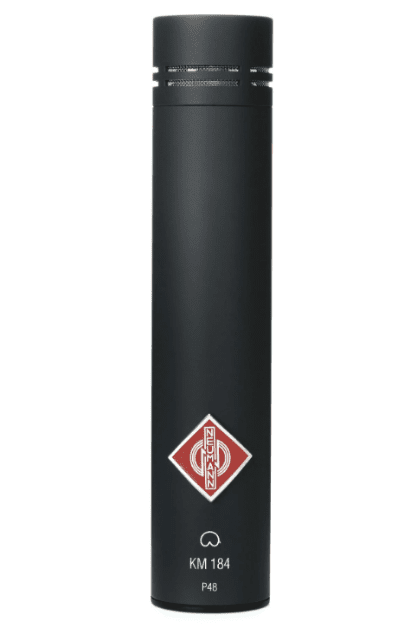
Neumann KM 184
An outstanding mic from the ultimate mic brand.
Neumann is arguably the most respected mic brand in history, and this mic is further proof of that. With stellar features and a transparent sound free of any coloration, this mic is a top choice for discerning musicians and engineers around the world.
The Neumann KM 184 is a small-diaphragm condenser mic with a transformerless microphone circuit and a cardioid pick-up pattern. This mic exhibits an impressively low inherent self-noise of 16 dB A-weighted so it remains ultra quiet at all times.
Although the KM 184 is one of the best choices you could make when recording your acoustic, this mic can also capture hot sources like percussion instruments, cymbals, and even brasses. This is thanks to its very high Max SPL of 138 dB. Having a high maximum sound pressure level is always a great trait, as it makes the microphone very versatile and capable of capturing many hot sources.
In our tests, we placed this Neumann in the usual position 12 inches from the 12th fret and got extremely clear sound reproduction that was devoid of any coloration. We were able to capture our Gibson Hummingbird with great nuance, as even our soft fingerpicking came through with great detail.
We then moved and pointed the KM 184 towards the bridge and got that more metallic sound from that area of the guitar. This mic captured the bridge tone of our acoustic with great accuracy and remained very smooth throughout all our tests.
The KSM 184 has a rather linear response with a small 3 dB bump at around 8 kHz and a roll-off that starts around 100 Hz. This gives the mic just a slight air quality on top and avoids any rumbling on the bottom. In short, a fantastic mic for discerning guitarists and engineers.
Verdict: The Neumann KM 184 is one of the best small-diaphragm condenser mics on the market today and a great choice for recording acoustic guitars. With a transformerless microphone circuit, extremely low self-noise and ultra-transparent quality, it is a top choice among professional guitarists and engineers.
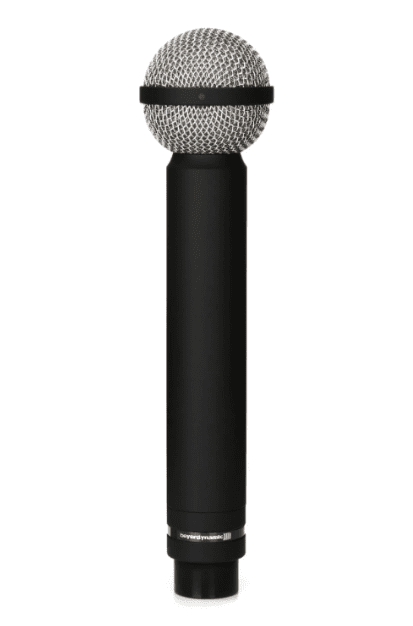
Beyerdynamic M 160 Double Ribbon
A unique design specially made for acoustic instruments.
A ribbon mic is nothing new, but a double ribbon one? Now, that is special! This mic employs a unique design and was made specifically for capturing acoustic instruments well, and comes from one of the most respected brands in the business.
The Beyerdynamic M 160’s defining feature is its two ribbons! Each of them measures only 0.002 of a millimeter in thickness and make up a very ingenious design.
These ribbons are arranged one above the other and are merely half a millimeter apart. The result of this Beyerdynamic’s inventive technical design is a mic that is sonically crystal clear and well defined.
This unique mic also features a hyper-cardioid pattern that does a great job at rejecting off-axis sounds, making it a fantastic choice as a stringed instrument microphone. Naturally, we had to put this to the test.
We tried our usual 12th fret setup and then moved on to our alternate bridge position (12 inches from the bridge, pointing the mic slightly angled at the guitar). In both instances, we got a very clean capture of our playing, with great nuance and detail.
Besides strumming a few open chords, and playing a few lines and riffs, we also tried some percussive playing where we would hit the body of the guitar in different areas as part of an elaborate accompaniment. We loved how the M 160 captured the transients of our percussive playing and gave us a very clear and transparent result.
This mic has a frequency response that goes from 40 Hz to 20 kHz. Although this is a bit more limited than your typical response of 20 Hz to 20 kHz, it made no difference in our tests, as this mic sounded full and captured the entire range of the guitar accurately.
This is a great choice as a clean mic for recording most things, including acoustic guitars. That said, traditional folks might prefer a standard pencil condenser instead of this unique two-ribbon design.
Verdict: The Beyerdynamic M 160 features a unique design with two ribbons. It offers fantastic clarity and transparency when capturing the acoustic guitar, and can be used for all styles of playing, including highly percussive techniques.
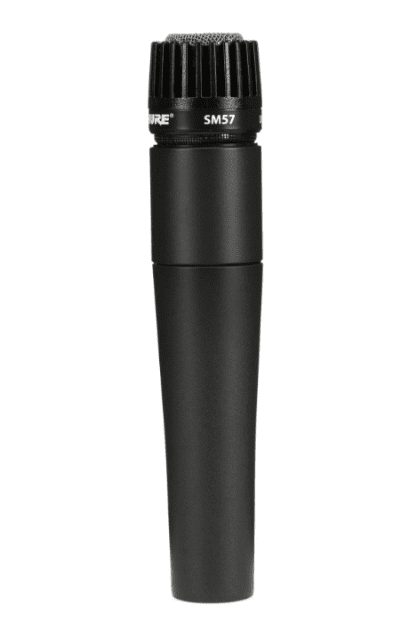
Shure SM57-X2u
The ultimate mic for recording electric guitar, now goes acoustic.
A unique way to get that legendary SM57 sound directly into your DAW, with no interface needed. With this mic, convenience meets tradition so you can lay down your ideas quickly without your gear getting in the way of your inspiration.
The Shure SM57-X2u offers you what may be the world’s best-known microphone with a convenient adapter/USB interface that lets you bypass an interface and plug straight into your computer.
As a matter of fact, the X2u adaptor will work in a plug-and-play fashion with just about any XLR-equipped microphone, including those that require 48 V phantom power.
This adaptor comes with a built-in headphone jack with volume control that lets you monitor as you record. The X2u records with a 16-bit and 48 kHz resolution and also features an onboard Monitor Mix Control for small adjustments.
In our tests, we tried the Shure SM57-X2u with our acoustic and the result was what we’d expect from an SM57. It captured our acoustic well and quickly, with convenience being the main selling point here.
This mic is a good choice for songwriters or any other composer who may want to get her or his ideas down fast, without having to spend any time plugging in an interface, etc. It is also a good choice for folks who know and like the quality of an SM57 and wish to capture their acoustics with it.
Although there is no arguing with the workhorse quality of the SM57 dynamic mic, some will prefer the clear quality and higher precision of a pencil condenser going through a traditional chain or interface.
Verdict: The Shure SM57-X2u gives you the sound of the world’s most professionally used microphone with the addition of a convenient adapter/USB interface that lets you plug directly into your computer. This mic is a good choice for those who love the sound of an SM57 and wish to use it on acoustic guitar with the convenience of the X2u adapter.
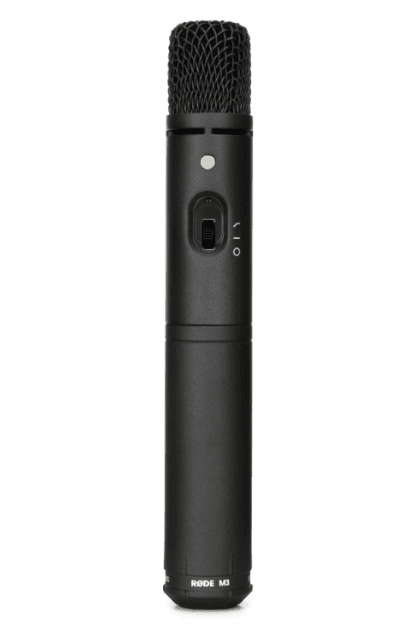
Rode M3
A good alternative for recording transparently.
Rode is known for providing solutions for musicians and engineers of all types. With this mic, they give us a good option to record acoustic guitar and much more, on a well-built and transparent microphone at a very attractive price.
The Rode M3 is a condenser mic with a cardioid polar pattern, a frequency range of 40 Hz to 20 kHz, and an output impedance of 200 ohms. In other words, this mic comes with the standard features you’d expect from a quality pencil condenser microphone.
It also features a spectacular maximum SPL of 142 dB, for recording very loud sources, and a sensitivity: of -40 dB +/- 3dB re 1V/Pa @ 1 kHz. As it is often the case with Rodes, the M3 offers you good features and solid construction at a very competitive price.
In our tests, we tried the M3 at the 12 fret position, with varying distances. First, we placed it at the standard 12-inch away position, and then we placed it at about 7 inches from the fretboard.
In both positions, the M3 mic gave us a clear picture of our Gibson Hummingbird acoustic and remained transparent and responsive to our dynamics and nuanced playing.
The curve of this mic is relatively smooth, with a very small bump of about 3 dB at 6.5 kHz, which then comes down to 1 dB and then rises up again 3 dB at 10 kHz. This gives the M3 just a bit of “air” while still retaining a transparent quality that accurately captures the acoustic guitar.
Another interesting fact about this mic is that it employs a permanently polarized condenser transducer that features an ultra-low noise electronic circuit with high immunity to R.F. interference for better performance.
Although this is a good mic with a clear sound, some folks may prefer a more conventional pencil condenser mic.
Verdict: The Rode M3 is a condenser mic that features a cardioid polar pattern, and offers you a clear sound when recording guitars and other sources. It has a very high Max SPL, which makes it more versatile, especially for louder sources. It is a good option for musicians who have home studios and want a good mic that remains affordable.
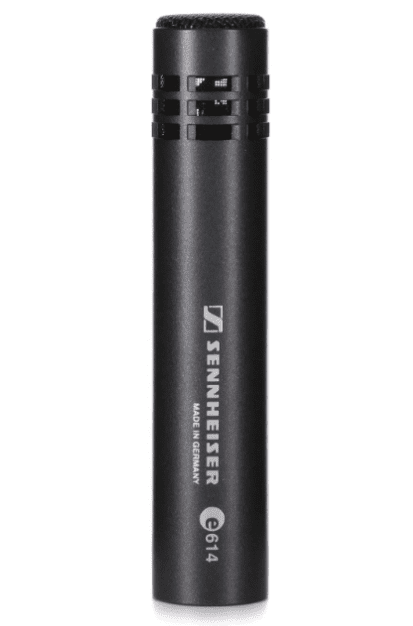
Sennheiser e614
A versatile option from a reputable company.
Sennheiser's e 600 series is known for offering high-quality instrument microphones for a variety of applications. One of the most respected microphone brands, Sennheiser delivers once again with the e614. This is a great choice for recording acoustic guitar and other sources.
The e614 is a super-cardioid electret condenser microphone that excels at acoustic guitar as well as other sources such as drums and percussion. This is thanks to its high max SPL of 139 dB.
This mic features a neutral sound that, along with its super-cardioid design, allows for some reflections of the room to be recorded. This is very useful if you have a nice-sounding room, and results in a natural-sounding acoustic guitar character that breathes.
We set this mic up in the usual position for our tests and started playing. We recorded everything from blues-type accompaniments, to open chords a la singer-songwriter, and even some single lines and double stops that can be used for embellishments.
The e614 captured all of our playing with great detail and in a very transparent way. It did not add any coloration, which is exactly what you’d want from an acoustic guitar mic. Everything from chords to lines and palm mutes sounded great, just like we had performed it.
In short, a very good option for recording acoustic guitars. While it typically is a good thing for a mic to be able to record other sources, some folks may want to look for a mic that was designed primarily for capturing acoustic guitars.
Verdict: The e614 is a super cardioid condenser microphone that does a great job at recording acoustic guitars as drums, cymbals, and percussion. With a high SPL, this is a versatile mic capable of capturing many sources with ease and conviction, the acoustic guitar being one of them.
How to Choose the Best Mic for You
There are different aspects to consider when buying a mic (or two). First, it is important to understand the different types of the most common microphones.
Condenser
When it comes to recording acoustic guitars, condenser mics are often the first choice of many engineers. Guitars have a broad frequency range that goes from about 100 Hz on the bass strings all the way to 10 KHz on highs and harmonics.
Condenser mics are especially suited for the task of capturing such a range. That is because they have very fine diaphragms that provide them with a wide frequency response that can capture the entirety of the range of an acoustic guitar.
Small diaphragm condenser mics, also known as pencil condensers because of their shape, are the go-to choice over large diaphragm condensers. This is because the small condensers can be easily aimed directly at the sound source.
On the other hand, large diaphragm mics are typically side-address. Not only are they difficult to directly point to the source (a guitar in this case), but part of the sound they capture will be off-axis, likely losing vital sound information in the process.
Ribbon
Ribbon mics are a common choice among savvy engineers that want to record with a particularly natural sound. These types of mics give you smooth warmth and beautiful top-end sparkle, resulting in greatly nuanced recordings.
Ribbon mics are also known for keeping your recordings free of coloration, as well as being quite sensitive. They are not as popular as pencil condensers for capturing an acoustic guitar but are a very good choice as well.
Dynamic
Dynamic mics are typically what you’d use on stage. They are sturdy, tough, and inexpensive. They are also a lot less sensitive than condensers or ribbons and are usually not a top choice for recording acoustics.
That said, some engineers swear by dynamic mic models for recording acoustics and obtaining great results. Like everything else, this comes down to a matter of experimentation, criteria, and taste.
Mono recording
If you only own one mic, then recording in mono is the way to go. The advantage here is that setup is fast and simple and the results can be quite good.
A good starting point for mono recording is to aim the mic straight at about 12 inches around the area where the body meets the neck. This is usually at the 12th fret but may vary depending on the acoustic guitar.
You may get fantastic results here. However, if it sounds boomy, try moving the microphone just a bit up the neck and record there. On the other hand, if you get a thin sound at the 12th fret position, then move the mic toward the body. Keep trying it out until you get a sound you like.
Stereo Recording
Recording in stereo provides ultimate fullness and depth but typically takes more experimentation and patience to get it just right. There are different techniques, but one of the most popular is spaced pair, particularly for home studios.
For a spaced pair, place one mic at the 12th fret area and another towards the bridge. A large diaphragm condenser can work well for the bridge position, while a pencil condenser points at the 12th fret.
Audition each mic separately for good sound before checking them out together. Make sure that the distance between the small diaphragm and large diaphragm mics is three times the distance to the guitar, at a minimum. Remember to be patient and take your time here.
Final Thoughts
Once you have a good song, a good player, and a good guitar, it all comes down to the mic you use to record and where you position it. Naturally, all mics are not created equal, and that remains true for those we use for recording acoustic guitars.
Ideally, besides all the conditions mentioned above (and they’re plenty!) you also want to have a good room to record in. However, whether you are recording at home or in a beautiful-sounding room, a good mic will likely do a great job of capturing an acoustic guitar.
To recap our top three choices, The Shure SM81 Small-diaphragm Condenser is our Top Pick with great quality at a fair price. The AKG P170 is our Best Budget Choice with a transparent and accurate sound that fits all budgets.
Last but certainly not least, the Neumann KM 184 is our Editor’s Choice, for professionals that are willing to pay for the superior quality and features from the ultimate mic company.

